Recently I’ve been thinking a lot about bread. With panic buying, stay-at-home orders and general fear and anxiety over the current state of affairs due to the COVID pandemic, I can see I’m not alone in thinking about bread. There are dedicated hashtags on Instagram (see #quarantinebaking, #stressbaking, and #bakecorona) alongside a slew of think pieces extolling the benefits of baking while confined indoors (see 1, 2, 3). I tried for weeks to buy yeast but to no avail and so like many others, I tried my hand at making a sourdough starter.
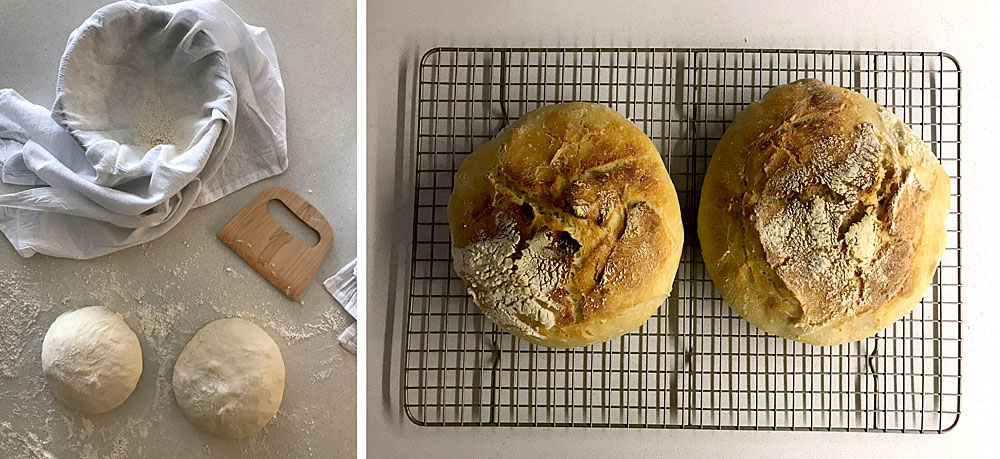
The images above are of my attempt in cultivating wild yeast to make my own sourdough bread. The results are mixed. The starter looked promising however my loaves turned out small, flat, dense and covered in parchment paper. It tastes good when toasted and I have high hopes for my next batch. I documented the entire process in my Instagram stores here. While this terrifying pandemic is circling the globe, I am trying to write my PhD thesis on food art. When I was in the final stages of my MA dissertation in 2007, I turned to baking bread as a way of coping with the stress. Since I am in my final year of my PhD candidacy, it was only a matter of time before I pulled out the container of flour and started kneading away.
Over the past five years researching food art, I noticed that again and again, artists used bread as a material for such artwork. As I found more examples of artists making sculptures, installations, and edible banquets with bread, I began collecting the research thinking one day post-PhD I will write an essay or do something with it. But as I said earlier, I’ve been thinking about bread a lot lately and so I figured now is as good a time as any to draw some of this research together.
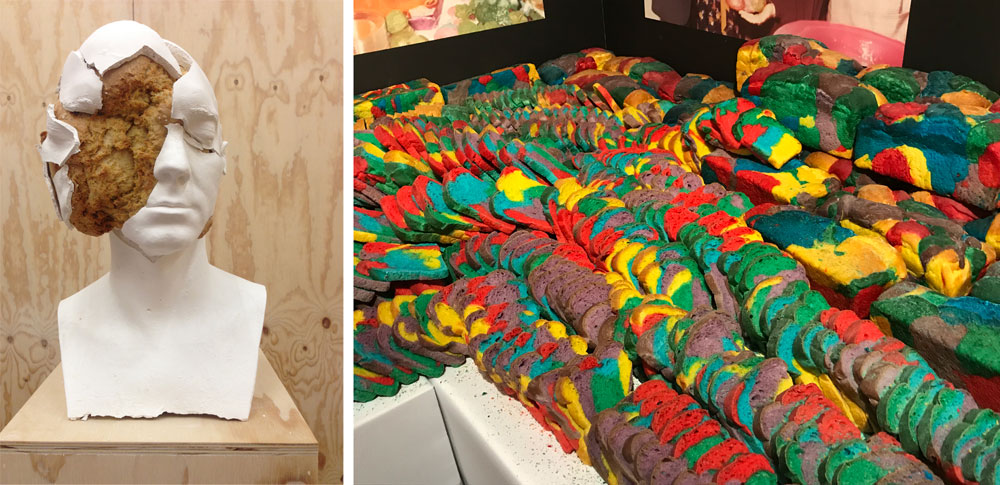
Right: Antoni Miralda, Coloured bread, 2019. Detail of exhibition installation, Making Art Public: 50 Years of Kaldor Public Art Projects, Art Gallery of NSW, Sydney.
My first thought was that artists used bread because, like ceramics, bread is baked in an oven and undergoes a material transformation. Baking is a powerful form of alchemy that can take three basic ingredients—water, flour, and yeast—and transform them into the ubiquitous foodstuff we all know and consume. When exposed to heat, bread dough swells, hardens, and mutates from the soft and malleable into a solid structure. This material transformation is highlighted in the 2015 series Oneirophrenia by Australian artist Tim Silver who filled plaster busts with dough that fractured and split when baked in an oven. The 2016 installation of these self-portrait busts at Artspace, Sydney left the gallery smelling like a bakery. I remember being drawn into the exhibition space by the aroma of toasted bread. I had a similar experience at the recent Kaldor exhibition at the Art Gallery of New South Wales. Spanish artist Antoni Miralda’s installation saw tables piled high with loaves and baguettes of hyper-coloured bread. Although I found the red, yellow, green, and blue bread unappetising, I noticed that some intrepid visitors had sampled slices of the artwork. Although audiences were not invited to eat this artwork, perhaps the yeasty scent of the bread proved too tempting for some.
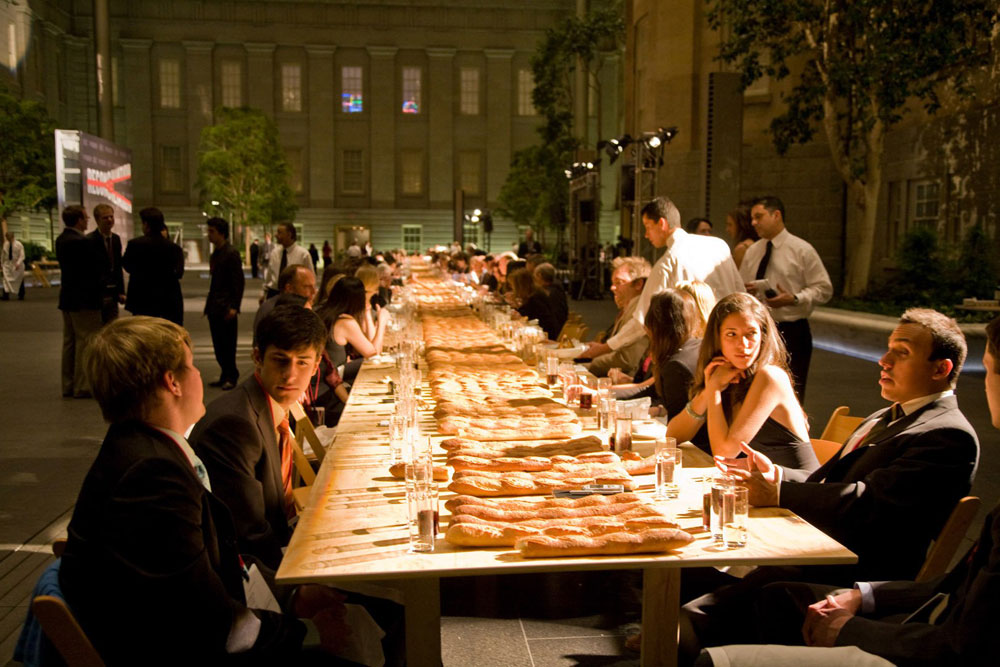
In contrast, American artist Jennifer Rubell’s 2009 banquet Reconciliation saw guests at the National Portrait Gallery seated at a long table laden with long baguettes. The intention was for guests to ‘break bread’, eat and share the foodstuff with one another. This phrase, ‘breaking bread’, is a figure of speech used to express sharing a meal and also a symbolic reference to the Christian Eucharist. Silvia Malaguzzi notes in Food and Feasting in Art, bread “enjoyed a certain sacred aura thanks to Christian tradition, in which it symbolized the body of Christ in the ritual of the Eucharist, a divine food offered to the faithful”. The rich symbolic history of bread as representative of not only the Christian faith but of hospitality and charity could be another impetus for artists to utilise the material in their artwork.
As Rubell describes on her artist website,
“Our first view is the bread, and we quickly understand that unless together we decide to break it, we will not eat. We will use that bread as a utensil, as a vehicle, as a means of connection to those around us. Breaking bread will be our first shared action. The bread will not reconcile our differences, but it will bring us into conversation. We will learn to give and to take.”
– Jennifer Rubell
Rubell’s meal offers guests the opportunity to not only taste the artwork but to forge new connections through the symbolic act of ‘breaking bread’.
These are but a few examples of food artists using bread in their artwork. Other notable artworks include Antony Gormley’s Bed (1980-81), Daniel Spoerri’s Catalogue Tabu (1961), Yonamine, Pão nosso de cada Dia (Our Daily Bread) (2016), Fiona Hall’s Crust (2014-15), David Wojnarowicz’s Untitled (Bread Sculpture) (1988-89), and Mario Merz’s Bread Igloo (1989) among others.
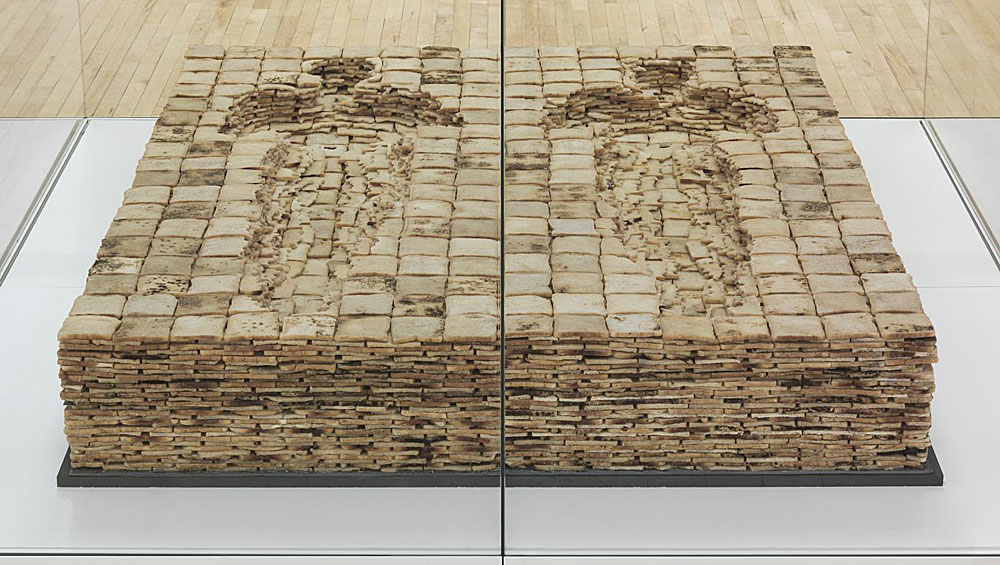
Antony Gormley, Bed. 1980-81 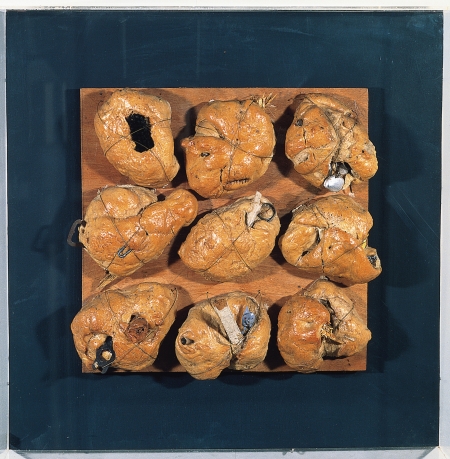
Daniel Spoerri, Catalogue Tabu. 1961 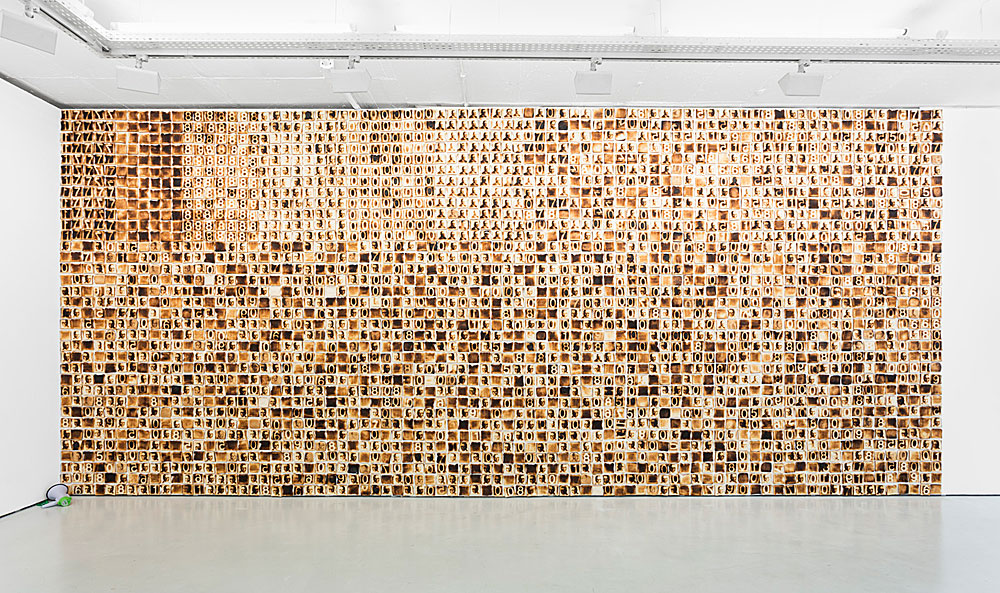
Yonamine, Pão nosso de cada Dia (Our Daily Bread), 2016, 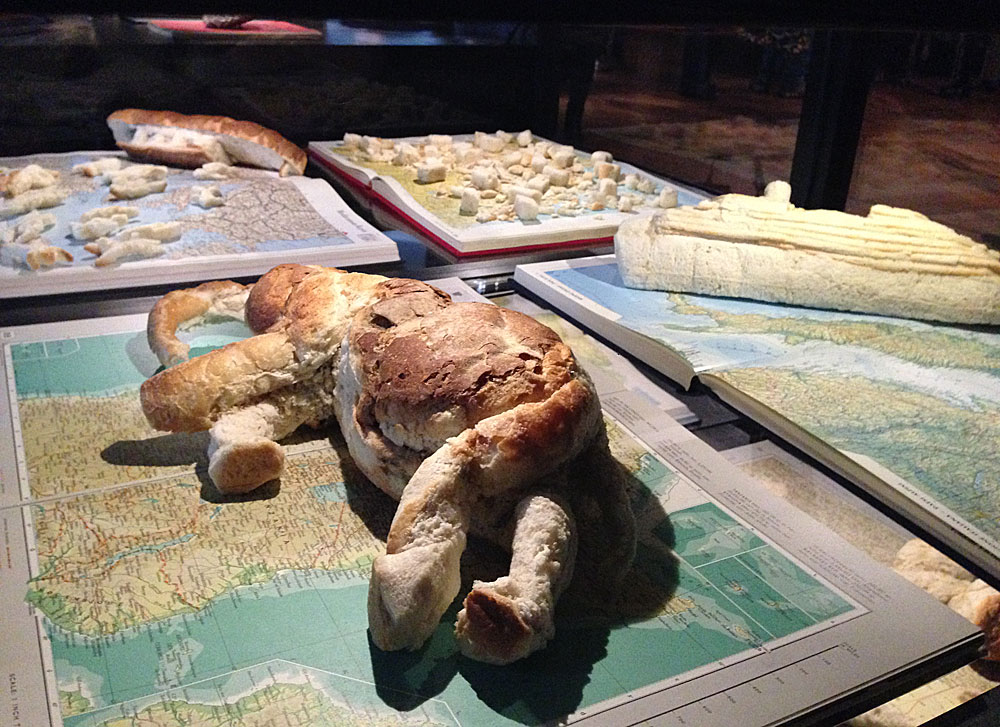
Fiona Hall, Crust. 2014-15 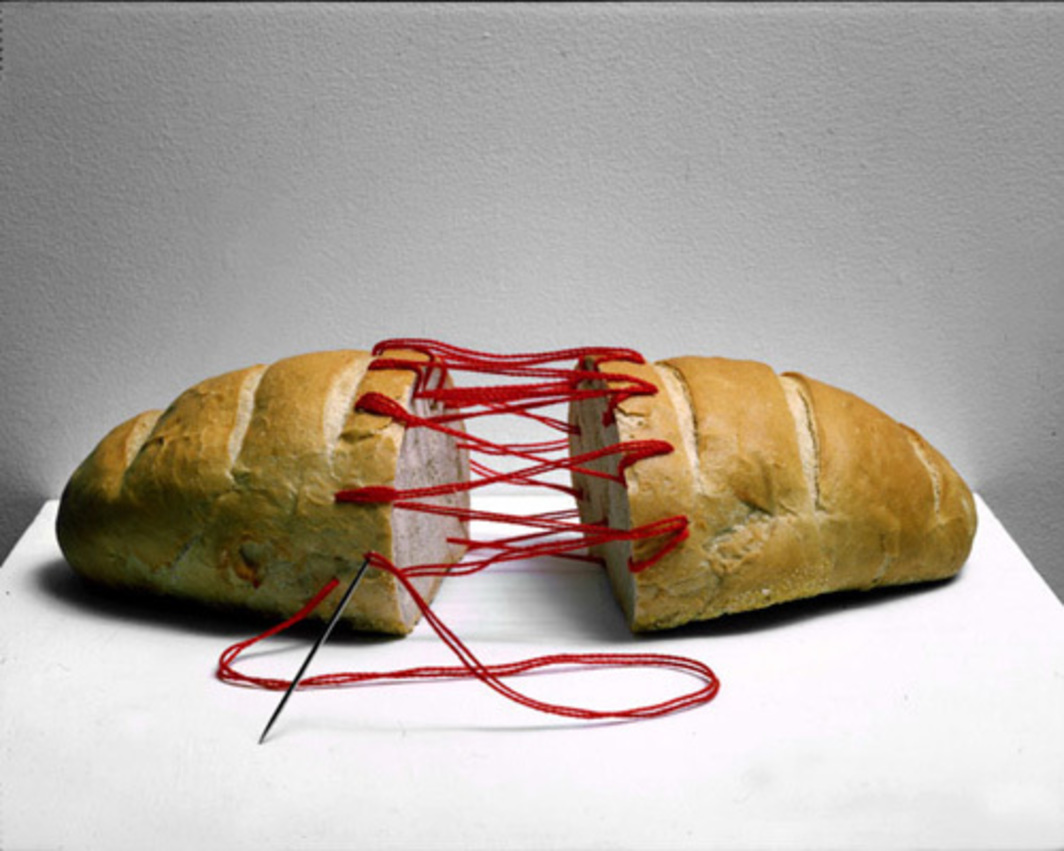
David Wojnarowicz, Untitled (Bread Sculpture). 1988–89 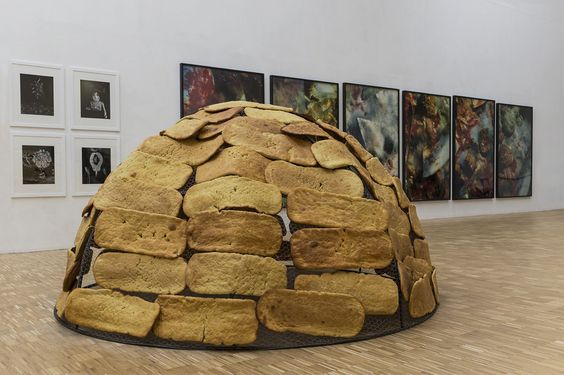
Mario Merz’s Bread Igloo, 1989

2 comments
Julie says:
Jul 10, 2020
I like the idea of using bread as a medium for artwork more than your earlier emphasis on researching the use of sugar in art. Just saying.
On ecology and bread (individual research making workshop) – Elina's research blog says:
Nov 15, 2024
[…] Bed, 1980-81, bread and wax, 28 × 220 × 168 cm. Tate Collection, London, England. from: https://www.antonygormley.com/works/sculpture/series/bread-works/bed Yonamine, Pão nosso de cada Dia (Our Daily Bread), 2016, toasted bread, nails, 11′ 5 3/4″ × 26′ 3″. from: https://www.artforum.com/events/yonamine-2-218654/ Fiona Hall, Crust 2014-15a series of small sculptures carved from baked bread installed on an open atlas, which represent various tragedies – environmental, cultural and militaristic – that occurred in the region on which it sits (Crust). (from: https://www.theguardian.com/artanddesign/2016/may/03/high-concept-high-craft-fiona-halls-must-see-exhibition-opens-in-canberra) Jasleen Kaur with the Portman Early Childhood Centre Everyday Resistance 2019 A Changing Play commission by the Serpentine Galleries Design: Cecilia Serafini Photograph: Mike Din. Everyday Resistance revisits the Portman’s community lunch programme of 2008, no longer in existence due to cuts in funding, where parents took it in turns to gather, cook a meal and eat together with their children. For this new iteration, the process centred on bread, a staple food stuff with endless variations. Families made bread together, learning a culturally significant recipe from a different group member each week. from: https://www.serpentinegalleries.org/whats-on/everyday-resistance/ American artist Jennifer Rubell’s 2009 banquet Reconciliation saw guests at the National Portrait Gallery seated at a long table laden with long baguettes. The intention was for guests to ‘break bread’, eat and share the foodstuff with one another. This phrase, ‘breaking bread’, is a figure of speech used to express sharing a meal and also a symbolic reference to the Christian Eucharist. From: https://www.feastingonart.com/2020/03/thinking-about-bread-and-art.html […]